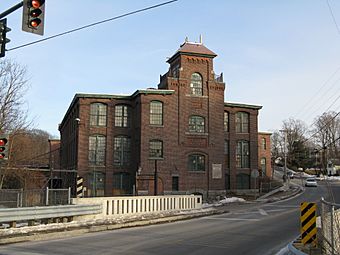Forge Village Historic District facts for kids
Quick facts for kids |
|
|
Forge Village Historic District
|
|

Abbott Worsted Company 1910
|
|
| Location | Westford, Massachusetts |
|---|---|
| Area | 250 acres (100 ha) |
| Architect | Harrington, P. Henry; et al. |
| Architectural style | Colonial, Federal |
| NRHP reference No. | 02000430 |
| Added to NRHP | May 2, 2002 |
The Forge Village Historic District in Westford, Massachusetts, United States, is a special area. It shows what a mill village from the 1800s looked like. The most important part of this district is the old factory complex. This factory belonged to the Abbot Worsted Company. The village grew up around this factory after it started in 1854.
Before the factory, this area was known for blacksmiths. They worked with iron, making tools and other metal items. There was also a fulling mill here in the 1700s. A fulling mill processed wool to make it thicker. The center of the district is where East and West Prescott Streets meet Pleasant Street. From there, it spreads out to ballfields, Abbot Street, and beyond Orchard Street. Many streets nearby have houses where the factory workers used to live.
The district was added to the National Register of Historic Places in 2002. This means it is an important place to protect because of its history.
Contents
What is the Forge Village Historic District?
A historic district is a special area that has important old buildings. These buildings tell us about the past. The Forge Village Historic District is one of these places. It is located in the town of Westford, Massachusetts. This district helps us understand how people lived and worked long ago.
The main focus of this district is a large old factory. This factory was once home to the Abbott Worsted Company. Around this factory, a whole village grew. It had homes for workers, shops, and other buildings. This shows how factories shaped communities in the 1800s.
A Look Back: Early History
Before the big factory was built, the area had a different purpose. It was known for its "forges." A forge is a place where metal is heated and shaped. Blacksmiths worked here, making things from iron. This is how the village got its name, "Forge Village."
In the 1700s, there was also a "fulling mill" in the area. A fulling mill was used to process wool. It would clean and thicken wool fabric. This was an important step in making clothes and blankets. So, even before the large factory, this spot was a place for industry.
The Abbott Worsted Company
The Abbott Worsted Company was founded in 1854. This company made "worsted" fabric. Worsted is a type of wool fabric known for being smooth and strong. It is made from long wool fibers that are combed straight. The factory became the heart of Forge Village.
Many people worked at the Abbott Worsted Company. The factory provided jobs for families in the area. It helped the village grow and become a busy place. The factory buildings are still a key part of the historic district today. They remind us of the village's industrial past.
Life in a Mill Village
When a large factory like Abbott Worsted Company started, it needed many workers. These workers needed places to live. So, houses were built close to the factory. These homes were often simple and built for families.
The streets around the factory became a community. Workers could walk to their jobs easily. The village grew with the factory. It had everything people needed, like shops and places for recreation. This setup was common for mill villages across New England during the 1800s.
Why is it a Historic District?
The Forge Village Historic District was added to the National Register of Historic Places in 2002. This is a list of places in the United States that are important to history. Being on this list helps protect these places. It means they are recognized for their special value.
Forge Village is important because it shows us a well-preserved example of a 19th-century mill village. The old factory buildings and the worker housing tell a story. They show how industry shaped communities and how people lived during that time. Protecting this district helps future generations learn about this history.



